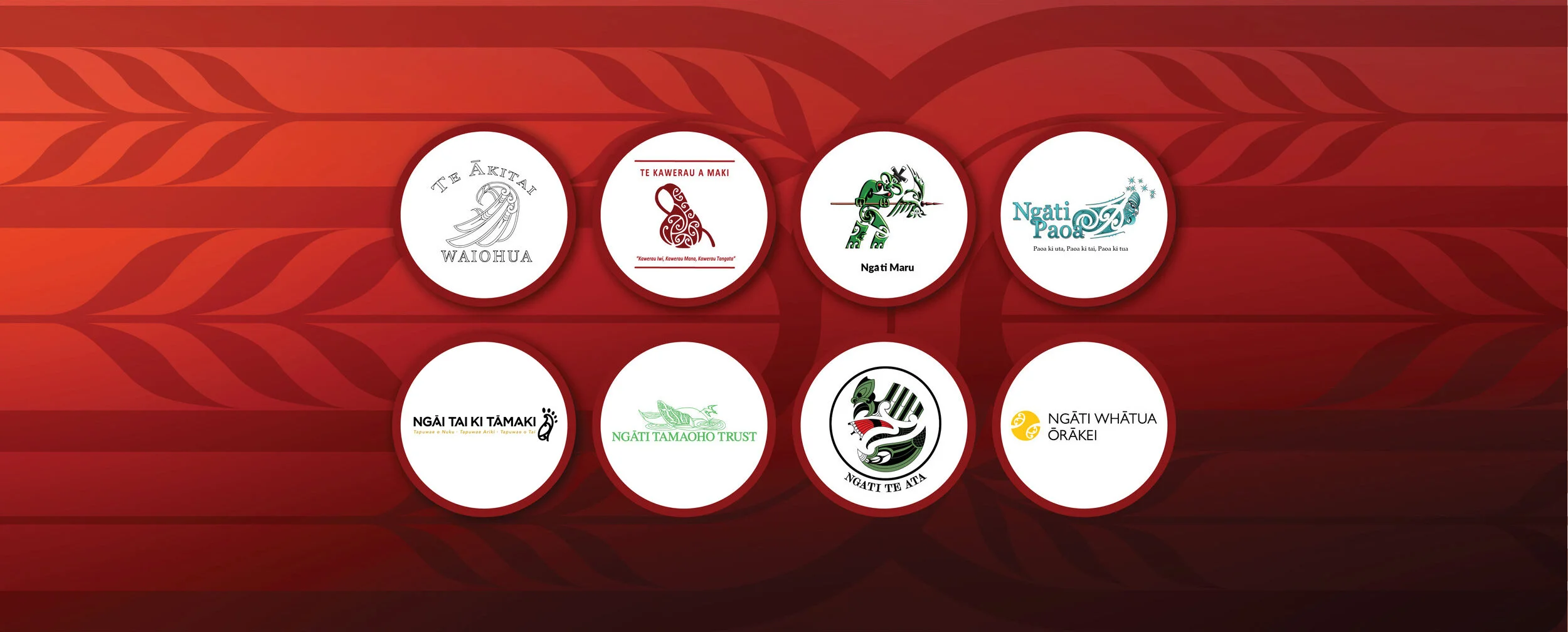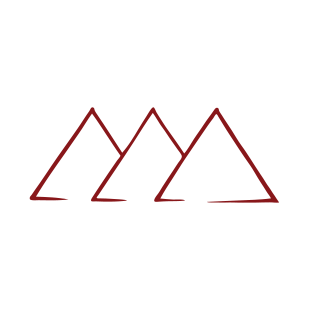Te Waka Tūhono (showing a “waka train”) is an image you may spot on hoardings around the CRL worksites.
This image of a waka train, created within CRL, represents the connection of traditional knowledge with today’s technology, the sharing of stories that have influenced design and the journey that has resulted.
It’s an image designed for the CRL’s social outcomes strategy, under development, which aims to improve the social wellbeing of Auckland’s people as well as its transport options.
The Waka Train story
During her time as CRL’s social outcomes manager, Berenize Peita authored the project’s social outcomes strategy. Prior to joining the team, she represented her iwi Ngāti Te Ata Waiohua at the CRL Mana Whenua Forum.
For the strategy, Berenize was looking for an image that represented her Māori world view and her current work environment. She enlisted the help of CRL graphic designer Geoff Fitzpatrick to give her ideas some substance.
Geoff said that he was immediately captivated by the idea and used his passion for design to take a picture that existed only in someone’s imagination and translate it into something tangible.
He also worked with artist Maaka Potini of Ngāti Tamaoho to include his original design for the taurapa (stern of the waka).
The Mana Whenua forum said the taurapa acknowledged the great fleet that brought Māori to New Zealand and the manaia (stylised figure) at the top is a tribute to all of the tōhunga (specialists in esoteric knowledge) that were aboard.
The tangata (person) below represents the captains. The two manaia at the bottom of the taurapa are the kaitiaki (guardians) that helped to protect the people and the waka. Maaka connects these attributes to those who schedule, drive and crew the trains.
“For me the image represents the past, present and future. Where Waitematā Station (Britomart) stands now used to be water and the image depicts the change from a traditional waka to a modern equivalent - a train,” said Berenize.
Left to right: Geoff, Berenize, Maaka
Mahi toi tūturu nā Maaka Potini
Te Kōrero Waka Tūhono
Nā te kaitohutohu whakawhanake pāpori na Berenize Peita i waituhi te rautaki tokonga hua a pāpori a te kaupapa. I mua i tana urunga mai ki te tira, he Māngai ia mo tāna iwi o Ngāti Te Ata Waiohua i runga i te Wānanga Mana Whenua a te CRL.
Mo te rautaki i kimi āhua a Berenize hei tauira i tana tirohanga a Māori ki te ao me te ao o te wāhi e mahi nei ia, ka whakapa atu ia ki te kaihoahoa whakairoiro a te CRL ki a Geoff Fitzpatrick, hei whakatinana i ana whakaaro.
He ai ki a Geoff mau tonu ake tōna whatumanawa i taua whakaaro ka whakapau ia i ona pukenga hoahoa ki te kapo atu i te āhua i roto kau i te tokonga whakaaro o tētahi atu hei whakatinanatanga māna.
I mahi tahi hoki ia me Maaka Pōtini o Ngāti Tamaoho me tāna whakairo taurapa waka motuhake.
He ai ki te wānanga Mana Whenua he whakatairanga ta te taurapa i te whakaheke nui a ngā waka i kawea mai ai te Māori ki Aotearoa, ko te tohu manaia i runga he whakamānawa ki ngā tohunga katoa o runga i aua waka.
Ko te tangata i raro he whakairo mo ngā kaiurungi i aua waka. Ko ngā manaia i te putu o te taurapa ko ngā kaitiaki i tū ārai mō te iwi i runga i aua waka. I tūhonotia e Maaka aua huanga ki te hunga whakarite wātaka, kaitaraiwa, hei kaimahi ināianei o runga i ngā tereina.
“Ki āhau e whakaahuatia mai ana e te tohu nei ngā rā ōnamata, o ināianei me apōpō. He wai i mua i te wāhi e tū nei a Britomart, ko ta te whakaahua mai ko te takahurihanga mai i te ao waka tūpuna ki tōna ritenga i ēnei ra – o te tereina,” hei ta Berenize.
Mana Whenua and the CRL Project
In 2012, CRL approached Mana Whenua across Auckland to explain the project, the area it would travel through and ascertain their wish to be involved.
A Mana Whenua forum was established and since then it has been formalised through the project’s legally binding consent conditions. Its members are:
Te Ākitai Waiohua
Ngāi Tai ki Tāmaki
Te Kawerau a Maki
Ngāti Tamaoho
Ngāti Maru
Ngāti Whātua Ōrākei
Ngāti Paoa
Ngāti Te Ata Waiohua
The role of the forum includes:
Developing practical measures to give effect to the principles in the Urban Design Delivery Work Plan (DWP)
Input into, where practicable, the design of the stations
Input into the preparation of the Construction Environment Management Plans (CEMPs) and DWPs
Working collaboratively around built heritage and archaeological matters
Undertaking kaitiakitanga (guardianship) responsibilities associated with the CRL project, including monitoring, assisting with discovery procedures and providing input of Maori mātauranga (knowledge) in relevant stages of the project
Providing a forum for consultation with Mana Whenua regarding the names for the CRL stations.
The forum meets monthly and as required has additional design, consent, sustainability and other workshops.
This video explores the Mana Whenua relationship
“Tikanga Maori encompasses an important system of customs and values to conserve, manage and protect natural and physical resources. In the Maori worldview, all natural and physical elements of the world are related through whakapapa (genealogy) and each is controlled and safeguarded through spiritual beings. All living things have mauri. The protection of mauri is essential.”
BLESSING: A dawn blessing for the re-opening of Britomart Station (Chief Post Office building) April 2021
Mana Whenua Case Study
The partnership between the City Rail Link Ltd and the Mana Whenua Forum, representing eight Tāmaki Makaurau iwi, is a ground-breaking exemplar of iwi engagement and collaboration for a large infrastructure project.
Due to the importance and success of the partnership, the Mana Whenua Forum asked CRL Ltd to formally examine and produce a case study setting out the evolution of the relationship, the outcomes achieved and the lessons learned.
This case study is part of the legacy of the CRL project and is intended to provide a framework for future large infrastructure developments to enter into mana whenua iwi partnerships for the benefit of all.
Mana Whenua Case Study (PDF 18MB)
Station designs and names
The Mana Whenua Forum continues to flourish and the iwi narratives have influenced the station designs, both the internal structure and the external appearance. The Forum has also gifted us names for the new CRL stations which have been approved by the New Zealand Geographic Board Ngā Pou Taunaha o Aotearoa.:
Maungawhau Station : A redeveloped station at Eden Terrace/ Mount Eden where the CRL connects with the North Auckland (Western Line)
Karanga-a-Hape Station: A new station just off Karangahape Road - with entrances at both Mercury Lane and Beresford Square
Te Waihorotiu Station: A new mid-town station with entrances at Wellesley and Victoria Streets
Waitematā (Britomart) Station: The existing station at the bottom of Queen Street transformed into a two-way through station that better connects the city’s rail network.
Find out more at the Meet Your Stations page below.
Design
DESIGN PRINCIPLES
Distinctly New Zealand
The urban design concept for the City Rail Link is to be authentic and representative of an approach to the very distinct way of living and constructing within the fragile and ever-changing New Zealand environment it sits within.
The station designs are developed to provide safe, functional and clear transport solutions. The key principles are Function, Performance and Personality with an overarching principle of Ecology. Each station has an even balance between functional design requirements, sustainability, engineering demands, performance objectives and cost, while reflecting the local culture, context and future city aspirations. Embedded in these is a holistic approach to the ecology and wider cultural landscape to ensure long-term social, cultural, heritage and environmental sustainability.
Personality
Each station is designed with a unique ‘personality’ – an identity developed from entrance through to platforms.
Ecology
Ecology is embedded into the design process to achieve integrated, cost-effective and innovative solutions in order create healthy, diverse and restorative environments.
Urban Design
The identity and integration of the stations into their local precincts will reinforce both their existing identities and a more pedestrian-focused future public realm in line with the City Rail Link intentions, Auckland Plan and Auckland City Centre Masterplan objectives.
Security
The principles of Crime Prevention through Environmental Design (CPTED) have been incorporated, as well as the optimisation of performance in terms of cost, maintenance and safety.
The forum has agreed on seven key design principles, which have been incorporated into the design framework. These are:
Mana – the need for relevant mana whenua groupings to have individual and collective high quality formal relationships with key stakeholders
Whakapapa/Whakamana – names and naming as a means of reconnecting iwi narratives to place
Tohu – the acknowledgement of wider mana whenua cultural landmarks
Taiao – bring landscape elements back into urban areas (e.g. water, trees, birds, and insects)
Mauri tu- maintaining and enhancing the environmental quality of water, air and soil.
Mauri toi – Re –inscribing iwi narratives into architecture, landscape architecture and urban design
Ahi ka – exploring opportunities to facilitate a meaningful living presence for iwi.
Mana
Whakapapa/Whakamana
Tohu
Taiao
Mauri tu
Mauri toi
Ahi kā
Sustainability
Mana Whenua have also worked with CRL to adapt and adopt the Infrastructure Sustainability Council of Australia’s (ISCA) criteria to reflect the New Zealand cultural context and this work has been recognised as a world first by ISCA. A Mana Whenua and a project representative attended a Sydney based ISCA conference to present on CRL’s approach to sustainability.
AWARD: The presentation of the IS "Leading" rating for Contract 2
Kaitiakitanga
Mana Whenua also exercise kaitiakitanga through input into construction staff inductions, cultural monitoring on site and a monthly walkover of the project area.
Read more in our sustainability section about
















